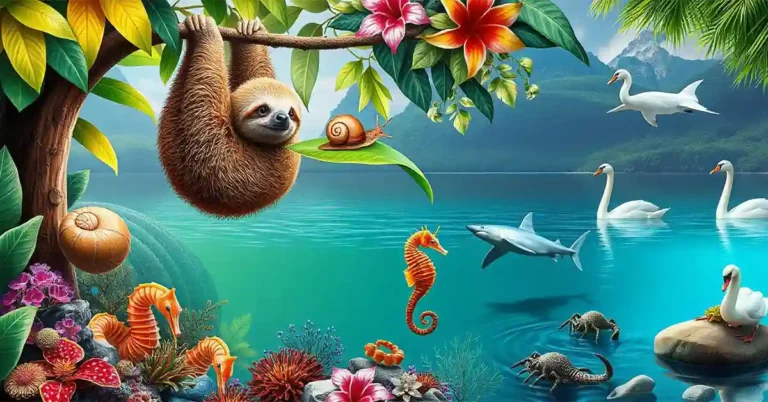Animals are incredible creatures that fill the world with wonder and beauty. Today, let’s explore a special group of them—animals that start with an “S.” These animals are not just unique in name but also in their characteristics and habitats. From the deepest oceans to the dry savannas, there’s so much to learn about these fascinating creatures.
What animals that start with an S can you think of? Perhaps a sloth, snail, or stingray comes to mind. This article will guide you through a delightful discovery of animals with an S. We’ll explore their habitats, special traits, and the roles they play in the environment. Do you know which of these animals is the fastest or most dangerous? Or which one has the most vibrant colors? Let’s find out together!
Learning about these animals is not only fun but also important for understanding the natural world. Animals play essential roles in the ecosystems, and knowing about them helps us appreciate the diversity of life. Get ready to be amazed and maybe even surprised as we venture into the world of animals that start with an S!
Sloths—Nature’s Slow Movers
Sloths are known for their slow movements and relaxed lifestyles. These tree-dwelling mammals live in the rainforests of Central and South America. Their slow pace helps them avoid predators, while their long claws make it easy to hang from branches.
Sloths have a unique diet mainly consisting of leaves. Because leaves are low in energy, sloths have a slow metabolism. Their slow movements help conserve energy. Sloths also have a strong grip, allowing them to stay in trees for hours without effort.
Did you know that sloths are excellent swimmers? They can hold their breath underwater for up to 40 minutes. Despite their slow land movements, they are surprisingly agile in water.
Snails—Masters of Adaptation
Snails are fascinating creatures with coiled shells. They can be found in gardens, forests, and even underwater. With over 1,000 species, snails are incredibly diverse and adaptable.
These animals have soft bodies and move using a muscular foot. They secrete a slimy mucus to help them glide over surfaces. Snails eat a variety of foods, including plants and decaying matter.
Snails play vital roles in ecosystems by aiding decomposition. They help break down organic material, returning nutrients to the soil. Snails also serve as food for many animals, making them an essential part of the food chain.
Sharks—Ocean Predators
Sharks are some of the most well-known ocean animals. With powerful bodies and sharp teeth, they are skilled hunters. Sharks can be found in oceans all over the world, from warm tropical waters to icy polar seas.
These fascinating creatures have excellent senses, including smell and hearing. They can detect vibrations from miles away, allowing them to find prey easily. Sharks come in many shapes and sizes, from the tiny dwarf lantern shark to the massive whale shark.
Sharks play a crucial role in maintaining ocean health. By preying on weak or sick animals, they help keep fish populations balanced. Protecting sharks is vital for preserving marine ecosystems.
Seahorses—Enchanting Ocean Dwellers
Seahorses are unique marine animals with horse-like heads. Found in shallow waters, they are masters of camouflage. Their unusual appearance makes them one of the most captivating sea creatures.
Seahorses have prehensile tails that allow them to anchor themselves to sea plants. They feed on tiny organisms called plankton. Interestingly, male seahorses carry the young in a special pouch, a rare trait in the animal kingdom.
These gentle creatures are popular in aquariums, but their populations are declining due to habitat loss. Conservation efforts are essential to protect seahorses and their habitats.
Scorpions—Desert Survivors
Scorpions are arachnids known for their stingers and pincers. They thrive in deserts, forests, and grasslands. These nocturnal hunters use their pincers to catch prey and their stingers for defense.
Scorpions have tough exoskeletons that help them survive harsh environments. They can go for months without food and are skilled in conserving water. Scorpions fluoresce under ultraviolet light, a useful trait for researchers studying them.
While scorpions may look intimidating, their venom is typically not deadly to humans. They play important roles in controlling insect populations, keeping ecosystems balanced.
Swans—Majestic Waterfowl
Swans are graceful birds known for their elegant long necks. Found in lakes and rivers, they are a symbol of beauty and love. Swans are strong flyers and excellent swimmers.
These birds are mainly herbivorous, feeding on aquatic plants and grains. They are often seen gliding across the water with their wings neatly folded. Swans form lifelong pair bonds, making them a symbol of fidelity.
Swans contribute to their habitats by spreading plant seeds and controlling aquatic vegetation. Despite their beauty, swans can be aggressive when defending their nests.
Salamanders—Secretive Amphibians
Salamanders are secretive creatures with moist, smooth skin. They inhabit forests, caves, and streams, often hidden under rocks or logs. These amphibians are known for their ability to regenerate lost limbs.
Salamanders have a variety of diets, including insects and small invertebrates. They play essential roles in controlling pest populations. Due to their sensitivity to environmental changes, they serve as indicators of ecosystem health.
Preserving habitats is crucial to safeguarding salamander populations. Pollution and habitat destruction are significant threats to these fascinating creatures.
Skunks—Nature’s Unwanted Guests
Skunks are small mammals known for their distinctive black and white markings. These nocturnal animals can be found in forests, grasslands, and urban areas. Skunks are famous for their potent scent glands, used for defense.
Despite their reputation, skunks are generally non-aggressive and only spray when threatened. They eat a varied diet, including insects, fruits, and small animals. Skunks are valuable to ecosystems due to their role in controlling insect populations.
Understanding skunks’ behavior can help reduce human-wildlife conflicts. Encouraging natural habitat preservation keeps skunks and other wildlife safe.
Starfish—Ocean’s Wonders
Starfish, or sea stars, are iconic marine animals with radial symmetry. Found in oceans worldwide, they are renowned for their vibrant colors and patterns. Starfish have a remarkable ability to regenerate lost arms.
These fascinating animals use tube feet to move and capture prey. They feed on mollusks and coral, using special stomachs to digest food externally. Starfish play vital roles in maintaining coral reef health.
Threats to starfish populations, such as pollution, impact coral reef ecosystems. Protecting oceans and marine habitats is essential for preserving these captivating creatures.
Squirrels—Acrobats of the Forest
Squirrels are agile tree-dwelling rodents known for their bushy tails. Found in various habitats, including forests and urban areas, they are familiar to many. Squirrels are excellent climbers and jumpers, using their tails for balance.
These lively animals eat nuts, seeds, fruits, and insects. They play key roles in seed dispersal, helping trees grow. Squirrels are known for their food-hoarding behavior, which helps them survive harsh winters.
While they may seem mischievous, squirrels contribute to their ecosystems. Observing their behaviors provides insights into forest dynamics.
Sandpipers—Shoreline Foragers
Sandpipers are small wading birds often found along coasts and wetlands. Known for their long legs and slender bills, they are excellent foragers. These birds migrate long distances, following coastlines and stopping at wetlands.
Sandpipers feed on insects, crustaceans, and worms, probing mud and sand with their bills. They have a strong sense of community, often flocking together during migration. Sandpipers are crucial for maintaining healthy shorelines and wetlands.
Protecting wetland habitats is essential for sandpiper survival. These birds rely on undisturbed ecosystems to breed and feed.
Sardines—Ocean’s Tiny Travelers
Sardines are small, silvery fish found in schools in oceans worldwide. These fast swimmers are vital to marine food chains, serving as prey for larger fish and marine mammals. Sardines play a critical role in maintaining ocean ecosystems.
These fish feed on plankton, filtering large amounts of water through their gills. Sardines are an important source of food for humans, providing essential nutrients. Overfishing poses significant threats to sardine populations.
Sustainable fishing practices are crucial to preserving sardine populations. Protecting these tiny travelers ensures healthy oceans for future generations.
Salamanders—Mystical Creatures of the Night
Salamanders are elusive and fascinating amphibians. With smooth skin and unique regenerative abilities, they captivate nature enthusiasts. Salamanders are found in forests, wetlands, and caves, often hiding under rocks or logs.
These creatures play a significant role in controlling insect populations. They are also indicators of environmental health, as they are sensitive to pollution. Salamanders’ ability to regenerate lost limbs continues to intrigue scientists.
Conservation efforts are essential to protect salamander habitats. Their presence and abundance reflect the health of ecosystems.
Snakes—Mysterious Reptiles
Snakes are intriguing reptiles with elongated bodies and scales. Found in diverse habitats, including forests, deserts, and wetlands, they are often misunderstood. Snakes play essential roles in controlling rodent populations.
These reptiles have various adaptations, such as venomous fangs and constricting abilities. Snakes’ movements are unique, as they slither across different surfaces with ease. Despite their fearsome reputation, most snakes are non-aggressive.
Understanding snakes’ ecological roles can help reduce human-snake conflicts. Conservation efforts focus on protecting snake habitats and populations.
Scarab Beetles—Nature’s Recyclers
Scarab beetles are diverse insects with strong bodies and fascinating behaviors. Found in many habitats, they play vital roles in ecosystems. Scarab beetles contribute to nutrient cycling by feeding on decaying matter.
These beetles have unique adaptations, such as powerful legs for burrowing. Some species, like dung beetles, are known for rolling balls of dung. Scarab beetles’ activities help maintain healthy soils and ecosystems.
Protecting these unsung heroes is essential for preserving natural habitats. Scarab beetles contribute to the balance and health of ecosystems.
FAQs With Answers
What are some animals that start with an S?
Animals that start with an S include sloths, snails, sharks, seahorses, and scorpions. These animals are diverse and possess unique characteristics.
Why are animals that start with an S important?
Animals that start with an S contribute to ecosystems in various ways. For example, sharks help maintain ocean health, while snails aid in decomposition.
How do sloths survive in the wild?
Sloths survive by moving slowly, helping them avoid predators. They have strong grips and camouflage themselves in trees.
Are snakes dangerous to humans?
While some snakes are venomous, most are non-aggressive and pose little threat to humans. Snakes help control rodent populations.
What roles do salamanders play in ecosystems?
Salamanders control insect populations and indicate environmental health. They are vital to maintaining balanced ecosystems.
Conclusion
Animals that start with an S offer us a glimpse into the incredible diversity of life on Earth. From the slow-moving sloth to the majestic swan, each creature plays a unique role in its ecosystem. Whether they inhabit rainforests, oceans, or deserts, these animals contribute to the balance and health of our planet.
Understanding and appreciating these animals is essential for promoting conservation efforts. Protecting their habitats ensures we preserve the rich tapestry of life for future generations. By learning about animals that start with an S, we foster a greater appreciation for nature and inspire positive actions to safeguard our natural world.






